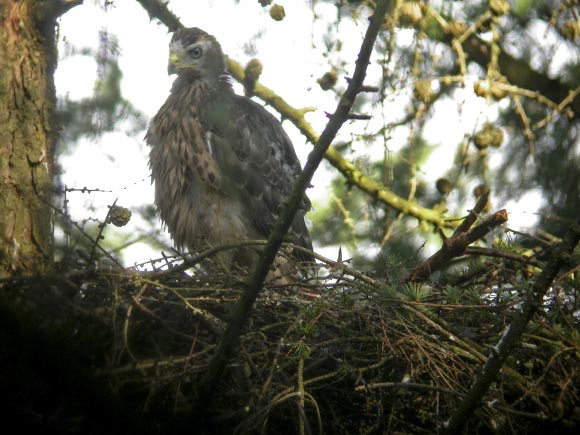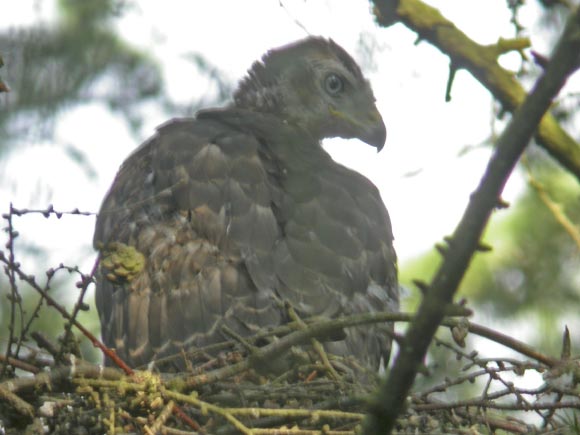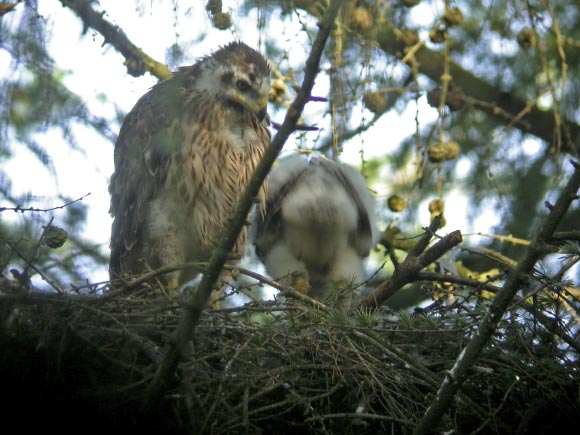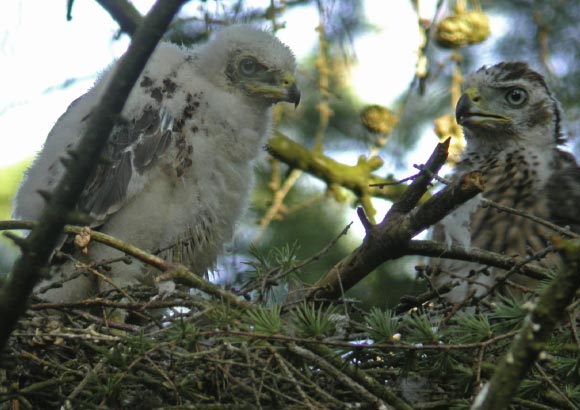BREEDING GOSHAWK IN SUSSEX 2009
By Paul Marten

Earlier this year, after observing prolonged display flights, and with
much searching, I was lucky enough to find a Goshawk nest, and was therefore
able to witness the first proven breeding of this rare and spectacular
bird in Sussex. Due to a lack of work, and the nestsite being less than
40 minutes drive from home, I was able to spend well over 200 hours
between March and July watching these shy and secretive birds successfully
raise 4 young. I thought people might be interested, so I decided to
do this very quick and simple write-up with a few photos of the birds.
The nest was built in late March and was situated about two-thirds of the way up a Larch Tree, approximately 45 feet from the ground. It was a huge structure, more than 4 feet across and over 3 feet deep, built entirely from Larch branches, some of which were over an inch thick.

the nest tree
In an otherwise open wood, with no natural cover, it was extremely lucky
that there was a large clump of young Spruce trees growing to one side
of the nest wood, as these afforded me perfect cover from which to observe
the nest. Like Christmas Trees, the branches of these trees reached all
the way to the ground and grew very close together. When I crawled underneath
them, it opened up into a sort of cave, from here I could sit quietly
and very comfortably, and watch the nest through a 6 inch opening I snipped
out of the foliage, from a distance of about 80 feet, and the birds never
knew I was there. As a testament to how good my cover was, I never heard
either of the adult birds give an alarm call or show any sign of agitation
or nervousness in the whole time I was present. Other bonuses to sitting
silently under a Christmas Tree in full camo, for hours on end, were the
pair of Firecrests that would hunt by my head, a male Muntjac that walked
within 6 feet of me one morning, and a Fox that actually came up and sniffed
my boot early one day. These interesting interludes were very welcome
as most of the nest observation during the incubation period was just
that......staring at a pile of sticks! Once every 4 or 5 hours the female
would shuffle around a bit, and if I was lucky, she'd stand up briefly
to turn the eggs, but for the vast majority of the time, all I would see
was her tail sticking up from the top of the nest. One very funny episode
involved a Squirrel which I watched coming down the nest tree, completely
unaware of what he was approaching. He came down the trunk and walked
onto the nest where the female was incubating. I held my breath and watched
him through my scope, wondering what would happen. All of a sudden, he
stopped dead in his tracks, did a really funny, cartoon-like double-take,
and his eyes almost bulged out of his head as he realised where he was,
and what was sitting in front of him. Before the Gos could react, the
Squirrel just leapt straight out of the tree and fell 45 feet to the ground
and sprinted off through the wood, faster than any Squirrel I've ever
seen. Despite this narrow escape though, I think his days were numbered.
 incubating female, see tail on left of nest.
incubating female, see tail on left of nest.
At some stage during the incubation period I started calling the female
Heidi, and the male, due to the fact that he was so elusive, and would
appear and then disappear like a ghost, Casper. God knows why, it just
seemed to fit, and as I was rapidly falling in love with them, naming
them felt like the right thing to do.
Once Heidi started to lay her clutch, she ceased hunting altogether, went
into moult and relied solely on Casper to provide for her. The whole basis
for the pair bond is built around the male's abilities and prowess as
a hunter, and in this department, Casper was certainly no slouch. When
Casper wasn't hunting he was usually sat somewhere in the wood near the
nest, but he NEVER EVER approached it, while Heidi was at home. In 6 months,
I never once saw him alight on the nest. Even when the chicks were quite
large, he would bring food to them on the nest, but he wouldn't land.
He would pass over the nest like a bomber, and drop the prey onto the
waiting young. Even this innocuous action would infuriate the female,
who would chase him out of the wood, screaming like a banshee. She simply
would not tolerate him near the nest. It's well documented that a female
can quite often kill her mate if he gets too close, a fact that Casper
was obviously fully aware of, and so Heidi did 100% of the incubating
and actual feeding. I would sometimes see his shadow above me as he glided
silently onto a perch, or he would call to Heidi to let her know he was
around, his piercing “kek..kek..kek” raising the hairs on
my arms whenever I heard it. I had one magical day when he actually landed
in a tree where I could see him through my scope, and I watched him preen
for 37 minutes.....wonderful!!! Casper didn't have a plucking post in
the traditional sense, he took all of his kills to an Oak Tree at the
edge of the wood, and plucked them there. He would take the prey, usually
a Wood Pigeon early in the season, eat the head, pluck the rest of it
and then call to Heidi with a soft, very quiet “guk” note,
and then fly off. Heidi would then slip silently off the nest, fetch the
prey from where he'd left it, and bring it back to the nest and eat it.
She was never away from the nest for more than a minute or two. It was
normally after she'd eaten, that all of my sitting silently, watching
sticks was rewarded, as it was at these times that she would sit on the
side of the nest and enjoy the sunshine whilst surveying her realm. It
was at these times that I'd attach my camera to my scope.
 Heidi brood patch very obvious
Heidi brood patch very obvious
 sexy
eyes
sexy
eyes
She once sat like this for 3 hours. Bum ache and cramp are soon forgotten
when a wild Goshawk is sat in front of you.
 queen of all she surveys
queen of all she surveys
After about 38 days, on or around the 12th May, the first egg hatched.
For the next couple of weeks everything carried on pretty much as before,
with the exception that Heidi could be seen stripping tiny pieces of flesh
from the prey items and feeding them to something. On occasions I could
hear cheeps from the tiny young, but because of the vast size of the nest,
I couldn't see them. Finally, towards the end of the month, I got glimpses
of them, and far as I could tell, there were two fluffy white dodo looking
chicks. They only popped into view now and again, but I managed to get
a record shot of them towards the end of the month.

 Itchy
& Scratchy
Itchy
& Scratchy
As they were both such scruffy looking characters, I named them Itchy
and Scratchy. I have to say, this wasn't in homage to Mr Packham's Poodles,
I named them before Springwatch started.
On the 7th of June both chicks were growing fast, as well as becoming
very showy, clambering around on the nest.It was whilst watching these
two that another one suddenly popped up.........there were three! This
one was christened Nutsy. I was really pleased with this as the New Forest
webcam nest only had 2 chicks, so I was thinking that Heidi and Casper
had done really well.

Nutsy
Blow me down if a few days later, yet another one appeared.....four! This
one was similar in size to the second chick, so I guess I'd been overlooking
him. The smallest of the brood was just a fluffy ball compared to its'
siblings, who by now had grown most of their adult feathers, so I was
pretty sure that it would either starve to death or be killed by its'
older nest mates. Not confident it would survive, I still gave it a name...............Trigger.
The following four pics were all taken on the same day. Not brilliant
pictures, but sufficient to tell each one from the others.
 Itchy
Itchy
 Scratchy
Scratchy
 Trigger
Trigger

Nutsy
As the chicks got older, due to their boisterous nature and constant clamouring
for food, Heidi spent most of the day away from the nest. She was still
relying on Casper for food at this point, but chose to spend her time
sitting in nearby trees watching the nest, sometimes just 15 feet or so
from me. This made it very difficult for me getting into the wood to watch
them, as I never knew where she was going to be, and I didn't want to
run the risk of spooking her. Because of this I had to start going in
before it got light, which was quite difficult, and so I started to visit
them less frequently.
By going less often, the growth rate of the chicks was really noticeable,
they seemed to really pile it on, thankfully the same went for Trigger,
who, within a short space of time seemed to catch up with his siblings
and was virtually indistinguishable from the others. The upshot of all
this is that on the 17th or 18th of June, all four fledged successfully,
and I had the privilege of watching all of them in flight. There had been
talk earlier on about ringing the chicks, and I was asked if it could
be done, but I said no. I don't agree with ringing, and as you can see
from the photographs, the birds are beautiful enough as they are.......they
don't need to be encumbered with pointless jewellery.






various shots of juveniles
Once the young had all left the nest, most of their time was spent sitting
in their father's plucking oak, 50m or so from the nest, waiting for either
Heidi or Casper to turn up with food.When they did, it was absolute bedlam,
with all four young fighting to get the prey item from the parent bird.
Five Goshawks fighting one another really is something to behold. Once
the nest had been abandoned I was able to approach the tree and look amongst
all the discarded bones and feathers to see what they'd been eating. I
also did the same thing under the plucking tree. I found innumerable Pigeon
bones, along with 22 Squirrel tails, as well as many Magpie, Jay and Crow
feathers. The most interesting remains were those of Blackbird, Moorhen,
Great Spotted Woodpecker and best of all, the remains of a male Sparrowhawk.
The most interesting, and I think, relevant discovery, when you think
of the reason gamekeepers persecute Goshawks, is that despite there being
a lot of Pheasants being reared very close by, I didn't find a single
bit of evidence relating to Pheasants being preyed upon. In fact it would
appear from my findings, that 90% of this pair's diet was made up of all
the species that Gamekeepers spend a lot of time trying to keep down.
 ex Sparrowhawk. Yes, I did bring it home and
keep it.....wouldn't you?
ex Sparrowhawk. Yes, I did bring it home and
keep it.....wouldn't you?
As July wore on, the juveniles started to disperse, going a little further
away from the natal site each week. All four appeared strong and healthy,
and hopefully will breed themselves in a year or two. By mid August the
wood was silent. I did see one of the juveniles briefly on October 18th
, still in the area. I know both Heidi and Casper are still around, [as
are Helga and Eric, but they're another story] and now I'm just looking
forward to next February, when it'll all start again...............I hope.
Thanks for reading and hope you found it interesting. Should you have any questions, my email address is paulfmarten@aol.com and I'll be happy to answer any queries you may have. The only question I'd rather not be asked is, “Can I see them?” coz, for obvious reasons, I'm afraid the answer has to be no.
Paul Marten
Schedule One license number: 20092221.